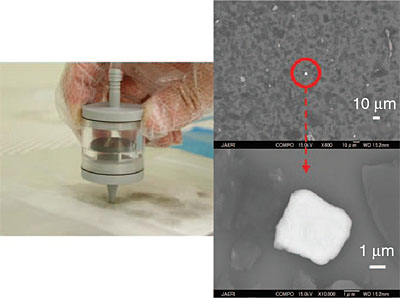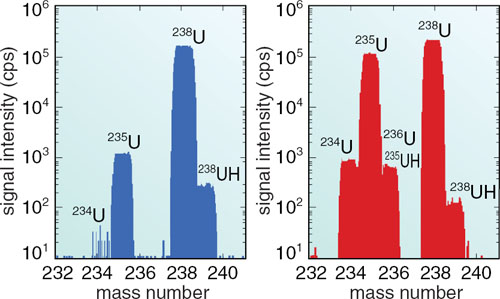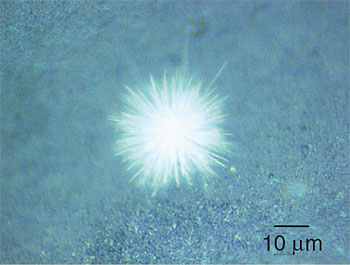Safeguards environmental sample analysis is a method to detect undeclared nuclear activities. Analyzed are the isotope ratios of trace amounts of nuclear materials in environmental (swipe) samples taken from the surfaces of equipment or floors in nuclear facilities. JAERI developed the analytical techniques at a clean-room facility (Clean Laboratory for Environmental Analysis and Research) and became a member of the IAEA's Network of Analytical Laboratories for both bulk and particle analyses.
One of the specific techniques developed for particle analysis is particle recovery by the Impaction method. In it, particles in a swipe sample are drawn into the inlet airflow of a suction pump and deposited directly onto a sample mount by inertial impaction (Fig. 9-1). This method minimizes fiber impurities and realizes appropriate particle dispersion. In Total Reflection X-ray Fluorescence Analysis, the noise level was reduced by irradiating X-rays at an angle smaller than the critical angle to a silicon mount with flat, smooth surface. This improved the uranium (U) detection limit from several nano-grams to ca. 30 pico-grams, which enables a preliminary estimation of the amount of U and simplifies the sample treatment process. These developments improved the accuracy of U isotope ratio measurement of individual particles by Secondary Ion Mass Spectrometry (SIMS) (Fig. 9-2) and the efficiency of the analysis.
For U particles less than 1 micrometer , which cannot be analyzed by SIMS due to its sensitivity limit, the Fission-Track method was developed for particle detection (Fig. 9-3). Work is in progress to accurately measure U isotope ratios by Thermal Ionization Mass Spectrometry.
In the future, application of the developed techniques and further technical advancements, such as improvements in sensitivity and throughput, will be made to contribute to the resolution of environmental problems as well as to the promotion of industrial activities and peaceful uses of nuclear energy. |


